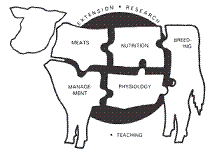Animal Science, Department of

Nebraska Beef Cattle Reports
Date of this Version
2010
Abstract
Estimates of variance components and heritability of average daily feed intake (AFI) and residual feed intake (RFI) were obtained using an animal model. Data were from 475 Angus steers raised and fed at the Circle A Ranch (Iberia, Mo.). Pedigree files were provided by the American Angus Association. Estimates of heritability after adjustment for average daily gain (ADG) were 0.56 and 0.60 for AFI and RFI. Selection for feed intake (FI) should be effective if FI records are available. Feed intake needs to be adjusted for age and weight on test. Carcass measurements (fat thickness and rib eye muscle area) were significantly associated with AFI and RFI, whether measured by ultrasound at mid-test or by direct measurement at harvest. With carcass measurements held constant, estimates of heritability for AFI were reduced from 0.35 to 0.21 (harvest) and to 0.26 (ultrasound), with the change due to a reduction in the estimate of genetic variance with little change in residual variation. For RFI, the estimate was reduced from 0.60 to 0.37 (harvest) and 0.40 (ultrasound) due to a reduction in estimates of genetic variance and an increase in estimates of residual variation. These results indicate estimated breeding values (EBV) or expected progeny differences (EPD) for fat depth and rib eye area of the carcass, as well for AFI and RFI and other economically important traits, should be weighted by their economic values and included in an economic index for selection.


Comments
Published in 2009 Nebraska Beef Cattle Report (Lincoln, NE: December, 2008). Copyright © 2008 The Board of Regents of the University of Nebraska.